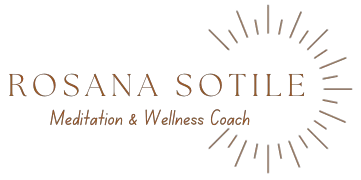Articles of Knowledge

Gratitude and Visualization for Manifestation
By: Rosana Sotile, Chopra Certified Well-Being Coach
According to happiness researcher, Sonja Lyubomirsky, people who feel consistently grateful also feel happier, more energetic, and more hopeful,
Change comes from desire. The thought, the feeling, the yearning for your life to be different. Whether you are experiencing pain, trauma, or just dissatisfaction with your current situation in life, it is natural to desire a different experience. While there are countless methodologies for exploring desire and setting intentions in the process of manifestation, there is, perhaps, one overlooked component for catapulting your results and speeding up the creation of your new reality: Gratitude.
The science of gratitude
Gratitude is directly linked to an increase in happiness. The world's leading scientific expert on gratitude, Robert Emmons, reveals how gratitude is related to happiness. In one study, they split participants into three groups. Every participant kept a journal. Each week the participants were asked to perform a task.
Group 1 wrote about five things they were grateful for.
Group 2 wrote about five things that displeased them.
Group 3 verbally described five events that happened.
At the beginning and end of the study, the participants’ happiness levels were assessed. After journaling for just a few weeks, those who wrote about gratitude were 20% happier. They reported feeling more joyful, attentive, energetic, determined, and strong than those who wrote about what displeased them. Where we focus our thoughts has a direct impact on our overall well-being and our perceived reality.
Of course it's easy to express gratitude when when life is going great, but what about gratitude practices when you're navigating difficult times?
Gratitude is a skill
Gratitude is possible even under difficult circumstances. Despite your present challenges that may be derailing you from realizing your intentions and desires, you still have the capability to "see" what actually is working for you in the present moment. Even when it feels like absolutely nothing is going right, or nothing you try is working, there will always be something for which you are grateful.
It takes skill and practice to shift your perception, even for a short moment, from struggling to grateful. This is because the human mind becomes trapped in a tunnel of fear-based emotions when its intentions and desires are not being fulfilled, or when experiences in life feel overwhelming. When we are too focused on what the future holds, we become blind to the present moment.
By intentionally shifting our thoughts to one or two things we are grateful for in the present moment, we create a small ripple through the darkness, letting in the right amount of hope. Over time, this creates mental and emotional resilience. We can compensate the struggles we face with gratitude for what we've already overcome.
The next time you struggle with difficulties, try asking yourself these few questions and reflecting on what comes up:
What did your past challenges teach you?
How did you grow?
What would your future self say you’ve learned from the challenge you’re experiencing today?
Waiting for a perfect future
In our human quest to end suffering, some people delay their own present-moment happiness in service of a perfect future that may never come. While delayed gratification can be a skill for achieving wellness goals (such as, limiting junk food or electronics), some people may take it too far, forgoing anything that brings them joy or happiness and neglecting their inner sense of gratitude.
A pattern of postponing fulfillment puts us into a chronic state of desire, wanting something in the future that doesn’t already exist. The idea that fulfillment can only be found when the conditions of life have changed is an illusion. We fool ourselves into believing that happiness and gratitude are contingent on something external.
How often have you caught yourself saying things such as, "If I could just find my soulmate, then I could be happy," or "If I could lose weight and keep it off, then I could be content." The notion of "if this happens, then I'll be happy" keeps us clinging to the idea that fulfillment can only be found when the conditions of life have changed. We then miss out on experiencing inner joy and fulfillment.
You can create a new reality when you can clearly see and connect with your future self, combined with appreciating what already exists in the present moment.
Using gratitude and visualizations for manifesting
Having a vision of your goals and desires, coupled with gratitude for yourself, sets you up for creating your new reality. And visualizing all of the steps in the process toward achieving your vision initiates that reality into existence.
According to goal researcher Heidi Grant Halvorson, it’s imperative to imagine every step of the process toward success—including the challenges you’ll overcome on the way.
This type of mental rehearsal is encouraged by sports psychologists and routinely used by high-level athletes. For example, legendary golfer Arnold Palmer used to prepare for an important golf round by lying down in his hotel room the night before and visualizing each shot he intended to make.
If you plan to run a marathon and only visualize yourself crossing the finish line, you miss a lot along the way. You must also envision all the steps it will take to run the race—including obstacles you might face, strategies you’ll develop, and hard choices you’ll make along the way.
So while you might enjoy visualizing yourself on a romantic beach in Bali with your new soulmate, this will be less productive than visualizing yourself with the resilience to go on dozens of dates, patiently and gratefully waiting to find your perfect match.
The efficacy of visualization is well documented
Brain studies reveal that thoughts produce the same mental instructions as actions. Mental imagery impacts cognitive processes including motor control, attention, perception, planning, and memory. So the brain is getting trained for actual performance during visualization.
In some cases, research has revealed that mental practices are almost effective as true physical practice. It’s also been found that mental practices can:
Enhance motivation
Increase confidence and self-efficacy
Improve motor performance
Prime the brain for success
Increase states of flow
Preparing your own visualizations, or using pre-recorded guides, can help keep you on track for reaching your goals and creating your new reality.
Listen to my "Best Day Guided Visualization" to help get you started! Please be sure to like and subscribe if it resonates with you:

Rosana Sotile is the founder of Sacred Space Health, LLC and holds certifications as a Well-Being Coach, Primordial Sound Meditation Instructor, and an Ayurveda Health Instructor from the Institute for Integrative Nutrition and Chopra Education. She has a passion for helping people discover their inner sacred space and embrace the power of manifesting new realities. She also enjoys spending her free time in nature, especially at home in South Louisiana with her four children and one cat.
Rosana can be reached at info@rosanasotile.com, or direct message on LinkedIn

